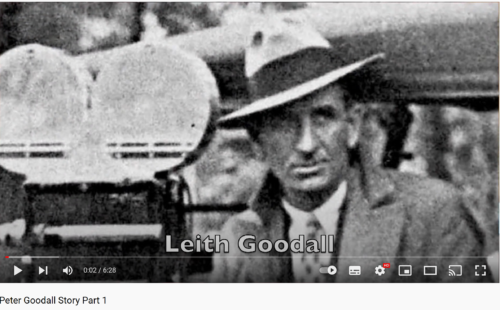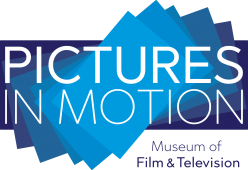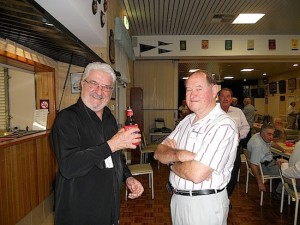Peter has been an AMMPT committee member in the past and strengthens the television background of the group. His experience provides a balance of expertise to the committee. Peter Goodall was a pioneering television news cameraman when TVW Channel 7 first opened, working there from 1959 to 1966. He later returned to be predominantly a studio director between 1979 and 1983.
Father Leith Goodall (1903-1978) was a founding member of the Western Australian branch of the Australian Cinematographers Society (ACS). Leith was posthumously inducted into the ACS Hall of Fame in 1998, in recognition of his outstanding contribution to the art of cinematography, and for distinguished service to the ACS.

No doubt father Leith was a big influence on both sons, as he enjoyed a long career, both behind the camera and exhibiting films. After working 20 years for Hoyts Theatres, in which time he became chief projectionist and theatre manager, he then spent four years as a cameraman for Fox Movietone News. In the 1940’s he formed in partnership, which resulted in Southern Cross Films Ltd. For six years, he produced a great number of documentaries in 16mm and 35mm for Government departments and industry. In 1947, when the Mayfair Theatrette was opened in the basement of Sheffield House at 721 Hay Street, Perth, the cinema owner soon found that he could not get newsreels from Cinesound Review or Australian Movietone News, so Leith Goodall was enlisted to produce a weekly “Westralian News”, which screened every Friday and ran for 35 weeks until the national newsreels were made available. Then in 1952, Leith joined the WA Education Department’s film unit and continued to produce documentaries and promotion programs for the WA State Government, including the WA Tourist Bureau. It was with this unit, a little later, that he would work with Daryl Binning, the founder of the Australian Museum of Motion Picture and Television (AMMPT), and Alex McPhee snr. Alex McPhee jun, would later work with Peter Goodall at TVW Channel 7, with Peter being an inaugural member of AMMPT and a member of the Western Australian branch of the Australian Cinematographers Society (ACS), like his father. Brother Michael Goodall started in television with the competition, WA’s second commercial television station, STW Channel 9, working in the film department and as the official stills photographer, before venturing into news camera work too. Later, he too was a cameraman in the newsroom at TVW from 1971 to 2003, continuing the Goodall family tradition. Michael Goodall covered the transition from film to electronic news gathering (ENG) between 1971 and 2003, whilst Peter also used ENG equipment on his move to the ABC in Perth.
Peter Goodall Story
Veteran cine cameraman Peter Goodall traces his story from his father’s influence as a pioneer himself, his introduction to television as a news cameraman to his career as a program maker, director and teacher. In Part 1, Peter describes the early tools of news gathering and the occasional tribulations.
Peter Goodall tells Richard Ashton about his most memorable experience as a News cameraman for TVW Channel 7 in Perth, during the first decade of television in Western Australia. Peter details the events surrounding Donald Campbell breaking the world water speed record on Lake Dumbleyung. He piloted his jet boat Bluebird K7 across the lake at the remarkable speed of 444.71 km/h (276.33 mph) in the afternoon of 31st December 1964. Sadly, on 4th January 1967, Campbell’s attempt to set a water speed record in the same boat on Coniston Water in Cumbria, England, of over 300 mph resulted in it crashing and killing him. The boat recovery was finally undertaken and his body located in 2001.
Veteran television program maker Peter Goodall has been a news cameraman and teacher in the field of cinematography and a live show studio director. In Part 3, Peter traces his time from leaving TVW Channel 7 in Perth during 1966 to teach, and then return following the death of this film pioneering father Leith Goodall in 1978. Peter returned to TVW in 1979 as a cinematographer to work with friend Brian Williams, but when the budget ran out, took on the role of studio director for the Stephanie Quinlan hosted Today Show.
Veteran cine cameraman Peter Goodall demonstrates a range of early cameras from an era when film was the prime visual source of television news coverage. As videotape equipment and electronic cameras became smaller, film was displaced by the new medium, which required no processing. The early 16mm black and white film was shot on reversal stock, which meant that the film shot by the camera was developed using a variety of chemical tanks to produce a direct positive image. That same film would then be edited and finally taken to telecine, where the moving image was projected onto an electronic camera tube, to produce the television image. The reversal film process avoided the need for a negative stage, which then would have required time consuming printing and further developing to achieve the normal positive image. The first camera shown is the Bell & Howell 70DR which had an impact when television stations ventured out of the studio and incorporated film into the nightly news programs. Some of the most dramatic close combat footage from the Vietnam war was shot using these cameras. The second camera is the Paillard Bolex automatic loading non reflex 16mm camera which was also a good animation camera. The third camera shown is the Cinema Products CP-16 Sound Camera, which was primarily designed for television news filming and were quite popular before the advent of portable videotape Electronic News Gathering (ENG) formats, as well as for documentary and drama production. They featured a magnetic audio system with a built in mixer that recorded onto special pre-striped 16mm single perforated magnetic sound film. It accepted a 400 foot film magazine.

